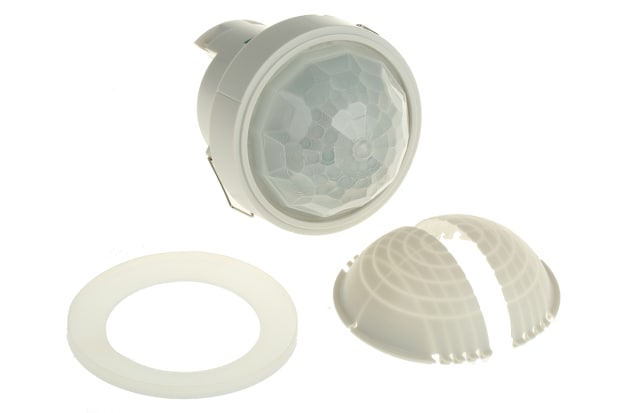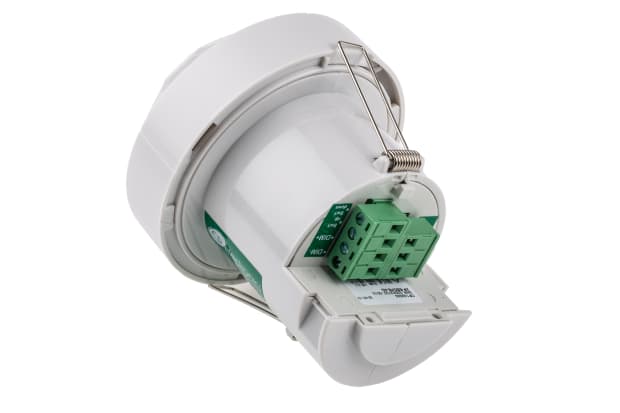- เผยแพร่เมื่อ 20 มี.ค. 2567
- แก้ไขครั้งล่าสุด 20 มี.ค. 2567
- 5 นาที
PIR Sensors Explained
Discover everything you need to know about PIR sensors in our guide, covering range, types & applications.

Passive infrared (PIR) sensors are commonly used for a variety of applications and security purposes. Read on to discover more about these components and how they can benefit your business.
What is a PIR Sensor?
PIR sensors are designed to recognise infrared light emitted by moving objects in the vicinity of the sensor. All objects and people that radiate heat also give off a low level of infrared radiation, relative to their temperature. The hotter an object, the more radiation it emits. These devices simply detect the IR and transmit it into signals that can be used to monitor locations for motion detection and security systems.
As a result, PIR sensors are widely used in thermal sensing applications including motion detection, security alarms, and automatic lighting. They are versatile and low-cost yet can bring a wide range of benefits.
As well as PIR, these devices are sometimes also referred to as passive infrared detectors (PID).
Uses & Applications

PIR motion sensors are often used in security systems and automatic lighting applications. They are versatile components that can be used in both internal and external environments.
Further uses and applications include:
- Movement detection
- Automatic security lighting
- Intruder alarm systems
- Motion-activated security camera networks
- Domestic security
- Industrial site security systems
- PIR-based workplace safety, shutting down potentially hazardous equipment if motion is detected nearby
Some models come with additional features such as pet-friendly technology to avoid animals triggering false alarms. This is particularly useful in domestic settings, although it can also be convenient if you only need to detect motion above a certain height, for instance.
It is also worth noting that PIR detectors can be used as standalone components or integrated into wider networks and security systems.
How Do PIR Sensors Work?
These devices are centred around two balanced strips of a pyroelectric material which are placed parallel to one another, creating a pyroelectric sensor. This detects thermal energy in the surrounding area. An infrared filter is also included to block out all other light wavelengths.
A Fresnel lens helps to focus the infrared energy on the sensor and increases the sensing range. This is achieved by the lens collecting light from multiple angles and focusing it into a single point.
If a change to the signal differential between the two pyroelectric elements is detected, the PIR sensor engages and sends an electronic signal to an embedded computer. Several things could happen in this instance depending on the setup, such as triggering an alarm or activating a security light.
Crucially, a PIR motion detector will not determine the specific location of an object. Instead, it merely tells you that an object has entered the detection area.

Construction & Appearance
Typically, the actual motion sensor will be housed in an airtight metal enclosure to protect against environmental variables such as moisture and extreme temperatures. This may be IP-rated, depending on the particular device. A window made from IR-transmissive material allows the detection to progress unimpeded whilst ensuring the sensing element remains protected.
PIR Sensor Range
The range, or sensor radius, will vary between different models and brands. PIR sensors tend to be fairly straightforward in themselves, so their sensitivity and range are two of the most significant factors to consider when choosing a PIR sensor.
The sensor radius can vary from as little as 30mm right up to 240m for covering significantly larger areas.
Some of the most common PIR sensor range options include:
What is the Difference Between Active & Passive Infrared Sensors?
There are two types of infrared sensors - active and passive. As explained above, passive IR sensors just detect infrared radiation and are used as motion detectors in a range of security applications.
On the flip side, active infrared sensors are more complex devices. The primary difference is that whereas passive sensors only detect radiation, active sensors both emit and detect it. There are two parts to an active IR sensor - a receiver and a light-emitting diode (LED). When an object moves within the sensor's range, the infrared light from the LED will reflect off the object. This will then be detected by the receiver.
Active infrared sensors are often used in robotics and obstacle detection systems.
Installing a PIR Sensor
Infrared motion sensors are typically straightforward to install. Before installation, however, it is important to familiarise yourself with the particular sensor's range. This will help you to plan an effective coverage system and ensure the entire area that needs covering will be monitored.
Common installation locations include ceiling or wall mounting as these tend to provide a clear, unimpeded view of the detection area. They may also be installed alongside wall lights, for example, in automatic lighting applications.
Most manufacturers will provide the necessary fixings needed to mount an adjustable bracket for the sensor.
These tips should help you to decide the best placement for a passive infrared sensor:
- Make sure all key areas are covered, including possible routes of entry, hallways, and corners
- Avoid installing sensors near radiators and air vents, for example, as temperature changes could impact reliability or result in a false alarm
- The ideal height for installation is typically 2-3 metres above ground level
- Avoid placing the sensor in direct sunlight